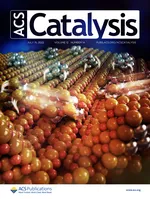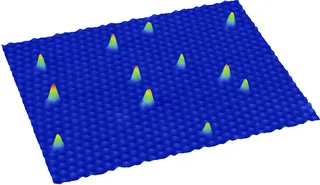Cluster Structure and Dynamics by Scanning Probe Microscopy (VTSPM)
At reaction temperatures (typically a few 100°C), a catalyst surface becomes dynamic and adsorbates, reaction intermediates as well as catalyst particles can move across the support. We use scanning probe microscopy (SPM) to monitor the cluster geometry and stability during a reaction and track mobile species on the surface.
The surface dynamical process that we investigate include
- temperature- and adsorbate-dependent stability of size-selected clusters on a support
- cluster-support interplay during reaction, such as reactant spill-over from active sites onto an inert support
- growth processes on surfaces, including polymerization reactions of small hydrocarbon molecules
Our current focus lies on Pt clusters on oxide surfaces, e.g. Fe3O4(001). Here, we are particularly interested in the role of surface defects on catalyst reactivity and in transport limitations when studying simple test reactions. Using our recently developed FastSTM module, we can measure two to three orders of magnitude faster than with conventional SPM instruments, such that we can measure at video-rate scan frequencies. This allows us to observe surface dynamic processes in situ with atomic resolution, even at elevated temperatures.
The above movie displays the dynamics of an Fe3O4(001) surface at 80°C. Specifically, the elongated bright species which jump between two distinct sites on opposite Fe rows can be identified as H atoms which jump between two O atoms of the substrate.
Laboratory and Scientists
- Johanna Reich
- Mina Soltanmohammadi
- Barbara Lechner
- Friedrich Esch (Coordination)
Funding




- DFG Research Grants (Projects ES 349/5-2 and HE 3454/23-2)
- DFG Collaborative Research Center 1441 TrackAct
- DFG Cluster of Excellence e-conversion
- ERC Starting Grant for Barbara Lechner (Project TACCAMA)
- EU Programme Horizon 2020 NFFA-Europe Pilot (NEP)
Collaborations
- Dr. Cristina Africh, Dr. Carlo Dri (CNR-IOM and ELETTRA Synchrotron, Trieste)
- PD Dr. Artur Böttcher, Prof. Dr. Manfred Kappes (Karlsruhe Institute of Technology)
- Dr. Wolfgang Harbich (EPFL, Lausanne)
- Prof. Dr. Uzi Landman (Georgia Tech, Atlanta)
- Prof. Dr. Gianfranco Pacchioni (Università di Milano Bicocca)
- Dr. Mirco Panighel (University of Luxembourg, Luxembourg)
- Prof. Dr. Gareth S. Parkinson (TU Wien)
- Prof. Dr. Renald Schaub (University of St. Andrews)
- Andreas Stierle (DESY, Hamburg)
Publications


- Reich, Johanna et al., Exploring the atomic-scale dynamics of Fe3O4(001) at catalytically relevant temperatures using FastSTM, Surf. Sci. 752, 2025, 122634
- Reich, Johanna et al., A Critical View on the Quantification of Model Catalyst Activity, Topics in Catalysis, 67, 2024, 880
- Kaiser, Sebastian et al., Does Cluster Encapsulation Inhibit Sintering? Stabilization of Size-Selected Pt Clusters on Fe3O4(001) by SMSI, ACS Catalysis 13, 2023, 6203−6213
- Briegel, Karl D. et al., PyfastSPM: A Python package to convert 1D FastSPM data streams into publication quality movies, SoftwareX 21, 2023, 101269
- Kaiser, Sebastian et al., Cluster Catalysis with Lattice Oxygen: Tracing Oxygen Transport from a Magnetite (001) Support onto Small Pt Clusters, ACS Catalysis 11, 2021, 9519–9529
- Esch, Friedrich, and Lechner, Barbara, The molecular wagon that stays on track, Science 370, 2020, 912-912
- Arndt, Björn, et al., Order–disorder phase transition of the subsurface cation vacancy reconstruction on Fe3O4(001), Phys. Chem. Chem. Phys. 22, 2020, 8336-8343
- Bourgund, Alexander et al., Influence of Local Defects on the Dynamics of O–H Bond Breaking and Formation on a Magnetite Surface, J. Phys. Chem. C 123, 2019, 19742-19747
- Dri, Carlo et al., The new FAST module: A portable and transparent add-on module for time-resolved investigations with commercial scanning probe microscopes, Ultramicroscopy 205, 2019, 49-45
- Lechner, Barbara A. J. et al., A Microscopy Approach to Investigating the Energetics of Small Supported Metal Clusters, J. Phys. Chem. C 122, 2018, 22569-22576
- Wang, Bo et al., Ethene to Graphene: Surface Catalyzed Chemical Pathways, Intermediates, and Assembly, J. Phys. Chem. C 121, 2017, 9413-9423
- Fukamori, Yves et al., Fundamental Insight into the Substrate-Dependent Ripening of Monodisperse Clusters, ChemCatChem 5, 2013, 3330-3341
